Literary criticism in Sinhala
by G. A. Muthupema
A new tradition of literary criticism is
a pressing need in Sinhala literature today. Sense, feelings and tone
theory of criticism propounded by I. A. Richards, which was the
foundation of our literary criticism is out of date today.
Literary criticism in Europe has its beginnings in Greece, where
Aristotle wrote his famous treatise on Criticism, Poetica. In India
literary criticism might have begun with the appearance of Natyashastra,
an erudite exposition on the drama and creative work, composed by the
Indian sage, Bharatamuni.
Beginnings of literary criticism in England could be traced to the
critical writings of John Dryden, which appeared in the earliest
magazines in England, Tatler and Spectator, in the seventeenth century.
Then there was Dr. Samuel Johnson, who was making scathing criticisms on
contemporary literary works and writing invectives on contemporary poets
and literati.
|
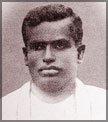
Munidasa Cumaratunga |

Martin Wickramasinghe |

Prof. Ediriweera Sarachchandra |
Along with the dawn of the Romantic age in the eighteenth century,
there began a revival in both poetry and criticism. The great romantic
poet, William Wordsworth brought out the famous collection of poems, The
Lyrical Ballads. The long introduction that Wordsworth wrote for the
above collection of poems, laid down new concepts of poetry and
criticism.
Poetry is the breath and finer spirit of all knowledge.
ďAll good poetry is the spontaneous overflow of powerful feelings.Ē
Contemporary critical writings also followed along the same lines.
There were critics such as Mathew Arnold, Swinburn and Lucas during the
Victorian age, which followed the Romantic age. During the Victorian
age, both poetry and criticism were at a low ebb.It was in this
atmosphere that T. S. Eliot brought out his new book Sacred Wood
surveying and evaluating the existing literary tradition in the light of
trends in European literature. This book which appeared in 1920
emphasised the need of new criterions and new outlook on literature. Dr.
I. A. Richards and F. R. Leavis collaborated with Eliot and brought
about a profound revival in poetry and criticism. They attributed a new
definition to the meaning of a literary work.
|
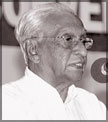
Dr. Gunadasa Amarasekara |
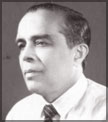
Prof. Nandasena Ratnapala |
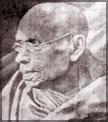
Ven. Hikkaduwe Sumangala Thera |
It entirely depended on the sense, feelings, tone and intention
discerned by a thorough study of the words of the text.Similar revival
in criticism took place in Sinhala literature in the nineteen fifties.
Before talking about that let us look back and briefly survey the
development of critical literature in Sinhala. In Sri Lanka, from the
time of the arrival of Buddhism, a tradition of writing commentaries
began. At first they were on Dhamma works and later commentaries began
to be written about literary works.
This tradition was kept alive by great Sinhala scholars such as
ven.Weliwita Saranangkara Thera during the seventeenth century and later
by such erudite scholars such as Ven. Hikkaduwe Sumangala Thera, W. F.
Goonawardane, Ven. Velivitiye Soratha Thera, who later became the Vice
Chancellor of the newly instituted Jayawardanapura Campus, then
Vidyodaya University and of course, the well reputed literati Munidasa
Cumaratunga.
Then there were the controversies over literary issues, poetry and
religious matters that were in the form of dialogues both oral and
written.
Weekly papers and periodicals which came up during the early decades
of the twentieth century became a fostering ground for these literary
controversies. In this respect weeklies such as Sarasavi Sandaresa,
Suadeshamitraya and Silumina were in the forefront.
In the long Sinhala literary tradition running for about two thousand
years, it has to be admitted that although there is an unparalleled rich
tradition in poetry, epic and narratives, there is a paucity of formal
critical literature. The situation is different in India, our
neighbouring continent. Very serious and comprehensive critical concepts
such as Rasavada and Dhvanivada were developed there. Great critical
works such as Dhvanyaloka were composed by eminent critics such as
Anandavardhana. I should say that this work Dhvanyaloka which means the
light of the metaphor can hold a candle to the best of critical works
produced in the middle of the 20th century, in England such as
Principles of Literary Criticism by I. A. Richards and Sacred Wood by T.
S. Eliot.
Revival of literary criticism
Now let us resume our talk leading to the revival of literary
criticism that took place in the second half of the twentieth century.
We have already been talking about the literary controversies and
dialogues that appeared during the first three decades of the twentieth
century.
Some of the prominent controversies were Savsathdamvada (dispute over
a poem), Kukavivada (who is the genuine poet) and Minisa Kuhakaya (man
is inherently wicked). Not only did these controversies foster an
interest among the common people, in literature, but also they
contributed their share to the development of a diction which came handy
when the true revival of Sinhala criticism took place in the second half
of the twentieth century. During the first half of the twentieth
century, the influence of European literature was strongly felt therein,
as novel, short story and essay were introduced. Pioneer novelists were
Piyadasa Sirisena and W. A. Silva. Piyadasa Sirisena wrote his novels
with a moral purpose. W. A. Silva on the other hand wanted to entertain
the readers. He wrote thrillers and historical novels.
|
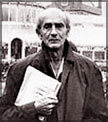
F. R. Leavis |

I. A. Richards |
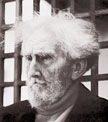
Ezra Pound |

T.S.Eliot |

John Dryden |
However poetry dominated the scene and it also has been influenced by
the Romantic poets in England such as Wordsworth and Shelley. Poets
during this period were known as the Colombo age poets. They conformed
to the metrical patten commonly used by the poets of the Kotte age.
This is known as the Samrddhaghosha Vritta and it has four lines with
end-rhyme, each line consisting of 16 syllables.
To develop a critical tradition along the lines of criticism that
arose in England since 1920, the background has been prepared by the
writings of Martin Wickramasinghe.
He was well versed in theories of Sanskrit criticism and had read
widely about the new European criticism. Not only did he write articles
and books about these new theories but also applied these new concepts
in evaluating literary works both ancient and modern.The true revival of
criticism, however started with the writings of Ediriweera Sarachchandra.
He was quite familiar with the new theories of criticism propounded by
I. A. Richards and F. R. Leavis and he had studied well Sanskrit
criticism, Rasavada and Dhvanivada. By transmuting the western and
oriental traditions in criticism, Sarachchandra wanted to evolve a
critical approach suited to Sinhala literature.
He began his practical criticism by applying his new theories to
Sinhala fiction.
At the beginning he cast his critical artillery on the novels and
short stories of W. A. Silva and this raised a hornetís nest.
Subsequently, Sarachchandra turned his attention on poetry.
He wrote the book Sahitya Vidyava, incorporating his new theories of
criticism. Professor Nandasena Ratnapala also followed in the footsteps
of Sarachchandra and turned to criticise contemporary literature.
Meanwhile, Gunadasa Amarasekara, the poet and novelist was experimenting
in his poetry to find out a suitable idiom and diction appropriate to
modern Sinhala poetry.
In poetry, vast changes were taking place. These were very much akin
to the revival in English poetry that took place in the third decade of
the twentieth century when free verse was introduced. Commenting on
these changes, the famous American critic, Ezra Pound said that if
English poetry were to be capable of conveying the complex experiences
of modern life, it must be released from the grip of the iambic
pentameter. Likewise, Sinhala poet and critic, Siri Gunasinghe said that
if Sinhala poetry were to make headway it must be taken out of the
quagmire of Samrddhaghosha Vritta. So a generation of poets who were
conveying complex emotional experiences through the medium of free verse
arose and their creative works were duly subjected to criticism by the
new literati.
Most of these creative and critical resurgence was associated with
the Peradeniya University and the host of these literary men were known
as the Peradeniya school. Sarachchandra was their maestro, Sarachchandra
had the knack for perceiving talent and originality in an amateur
creative artiste. Many a reputed writer of fiction in Sri Lanka has been
brought to limelight through the criticism of Sarachchandra. The best
example is Gunadasa Amarasekara.
Originality
I remember once listening to Sarachchandra discussing the poetry of
Monica Ruvan Patirana over a classical program in SLBC. Monica was a
nonentity, at that time. Sarachchandra recognised the originality in her
poetry.
Along with the revival of literature brought about by the Peradeniya
School, a tradition of criticism evolved gradually. Its progress was
accelerated by the inauguration of the two new universities - Vidyodaya
(Jayawardhanapura) Vidyalankara Kelaniya).Sinhala departments of these
new universities became a fertile field for the seeds of criticism to
grow.
Several magazines entirely devoted for literary criticism, along the
lines of Scrutiny, a magazine in England, solely meant for literary
criticism appeared. Many new critics sprang forth from among the
undergraduates and some of them reached the stature of mature critics.
In the sixth and seventh decades of the twentieth century, both
creative literature and criticism ran parallely. Whenever a new work of
fiction or a collection of poems appeared, there were reviews and
criticisms of them appearing subsequently in weekly papers, dailies and
periodicals.
So the general public became familiar with the literary works and an
awareness of the literary trends in contemporary society was cultivated,
particularly, among the younger generation.
Now, it seems that things have turned topsy-turvy. Owing to the
introduction of free-enterprising capitalism, interest in literature has
atrophied to a great extent. Everything, including, literary works, is
being reckoned in commercial values. Intrinsic value of a book is
overlooked.
Cover design, quality of paper and have become the criteria of
judging a book. The minds of the young are incessantly assailed by the
blaring advertisements of the Radio and TV. Their heads are full of
commercial advertisements and it seems that there is no room in them for
literature.Impartial criticisms on literary works hardly appear in the
papers today.
I remember as a school boy when Gamperaliya by Martin Wickramasinghe
was published in 1940s. There were reviews of it in almost all the
papers. Still I remember having read a criticism of the novel, running
to one whole page in the weekly paper Sinhala Balaya. After reading that
a curiosity arose in me to read the novel somehow or other.
When my first novel was released forty years back, I sent copies of
that to almost all the dailies, weeklies and periodicals, as the normal
practice was then. In due time reviews of my novel appeared in most
papers. I still remember a long critical analysis of it published in the
then Lankadipa Sunday issue. It was reviewed by no less a person than
Professor Nandasena Ratnapala. The title of the review was A Good Novel
from an Amateur Writer. At that time I have never seen or known
Professor Ratnapala.
A new tradition of literary criticism is a pressing need in Sinhala
literature today. Sense, feelings and tone theory of criticism
propounded by I. A. Richards, which was the foundation of our literary
criticism is out of date today.
New theories of criticism such as the Post-modernistic criticism have
come into being.
There are the reader-response theory and the theory of symbolic
action, propounded by the American critic, Kenneth Burke.According to
these new theories, the meaning of a literary work does not entirely
depend on the words of the text alone as stated by I. A. Richards and F.
R. Leavis. According to these new critics, the words that a writer uses
do not belong to him alone. Words belong to society.
So through a literary work, apart from the intention of the writer,
society also speaks. So in getting at the meaning of a literary work,
the critic has not only to find out the intention of the writer, but
also he has to take into consideration the society, time of creation,
readerís mentality and the unconscious mind of the writer.
In developing a new approach to Sinhala criticism, all these factors
will have to be taken into consideration.
(The writer is a novelist and a critic) |

